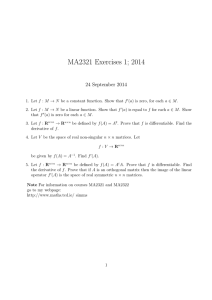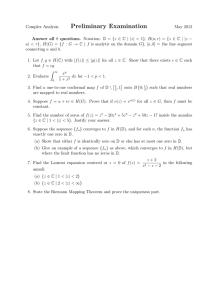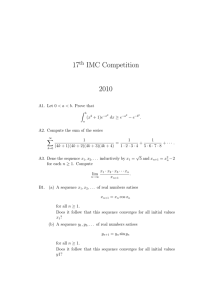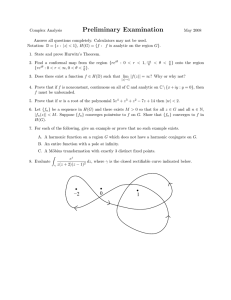Faculty of Engineering, Mathematics and Science School of Mathematics
advertisement
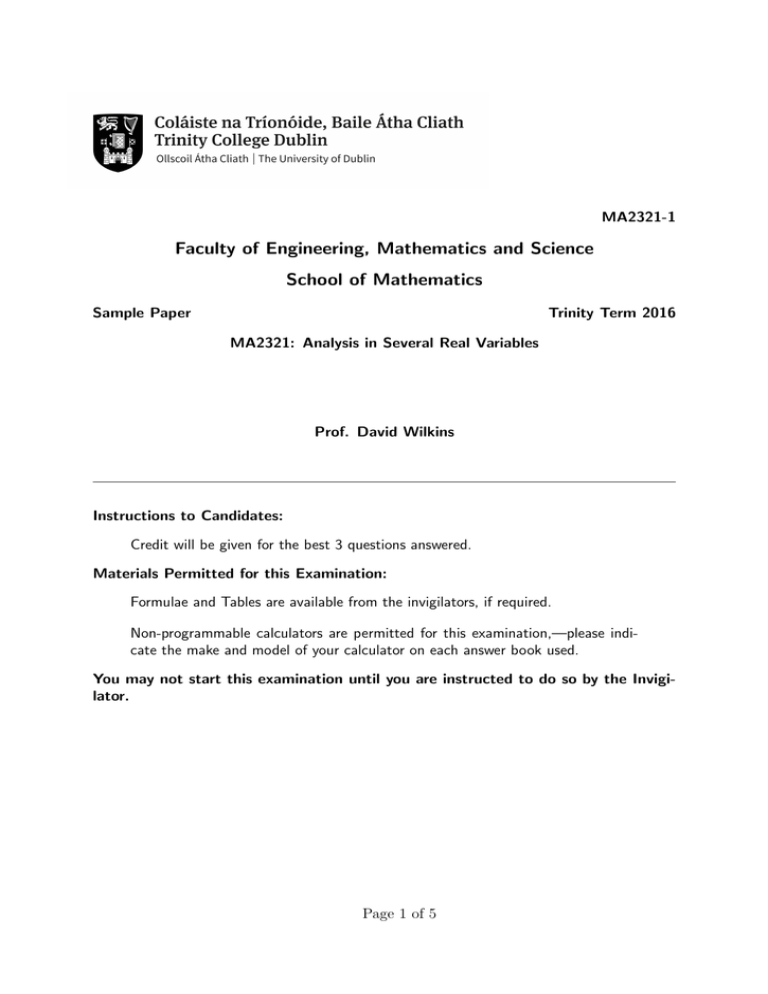
MA2321-1 Faculty of Engineering, Mathematics and Science School of Mathematics Sample Paper Trinity Term 2016 MA2321: Analysis in Several Real Variables Prof. David Wilkins Instructions to Candidates: Credit will be given for the best 3 questions answered. Materials Permitted for this Examination: Formulae and Tables are available from the invigilators, if required. Non-programmable calculators are permitted for this examination,—please indicate the make and model of your calculator on each answer book used. You may not start this examination until you are instructed to do so by the Invigilator. Page 1 of 5 MA2321-1 1. (a) State Rolle’s Theorem. (3 points) (b) Let f : D → R be a 3-times differentiable function defined over an open interval D, where 0 ∈ D and 1 ∈ D. Suppose that f (0) = f 0 (0) = 0 and f (1) = f 0 (1) = 0. Prove that there exists some real number θ satisfying 0 < θ < 1 for which f (3) (θ) = 0 (where f (3) (θ) denotes the third derivative of the function f evaluated at θ). (5 points) Taylor’s Theorem may be stated as follows: Let s and h be real numbers, and let f be a k times differentiable real-valued function defined on some open interval containing s and s + h. Then f (s + h) = f (s) + k−1 n X h n=1 n! f (n) hk (k) (s) + f (s + θh) k! for some real number θ satisfying 0 < θ < 1. d (exp(x)) = dx exp(x) for all real numbers x. Use Taylor’s Theorem to prove that m X xn exp x − ≤ bm+1 (x) exp(|x|) n! n=0 (c) The exponential function is characterized by the property that for all real numbers x and positive integer m, where bn (x) = |x|n /n! for all positive integers n. Determine a value of the positive integer N , depending on x but independent of the value of n, that is large enough to ensure that bn+1 (x) < 12 bn (x) whenever n ≥ N . Hence or otherwise, prove that exp x = lim m→+∞ m X xn n=0 n! . (12 points) (End of Question) Page 2 of 5 MA2321-1 2. Let a and b be real numbers satisfying a < b, and let f : [a, b] → R be a bounded function defined on the interval [a, b]. (a) Define the concept of a partition of the interval [a, b]. Give the definition of the lower sum L(P, f ) and the upper sum U (P, f ) of f for the partition P . (5 points) Rb (b) Define the lower Riemann integral L a f (t) dt and the upper Riemann integral Rb U a f (t) dt of f on the interval [a, b]. Define precisely what is meant by saying that the function f is Riemann-integrable on [a, b], and define the Riemann integral of a Riemann-integrable function on [a, b]. [Your definition of Riemann-integrability should be expressed in terms of the lower and upper Riemann integral.] (5 points) (c) Let f be a continuous real-valued function on the interval [a, b], where a < b. Prove that d dx Z x f (t) dt = f (x) a for all x satisfying a < x < b. [You may assume without proof that all continuous real-valued functions on [a, b] are Riemann-integrable.] (6 points) (d) Let f be a continuously differentiable real-valued function on the interval [a, b], where a < b. Prove that Z a b df (x) dx = f (b) − f (a). dx (4 points) (End of Question) Page 3 of 5 MA2321-1 3. Throughout this question, let X and Y be subsets of Euclidean spaces Rn and Rm of dimensions n and m respectively. (a) (i) Define what is meant by saying that a function ϕ: X → Y from X to Y is continuous at a point p of X. (ii) Define what what is meant by saying that an infinite sequence x1 , x2 , x3 , . . . of points of Rn converges to some point p of Rn . (iii) Define what is meant by saying that a subset V of X is open in X. (6 points) (b) Let ϕ: X → Y be a continuous function from X to Y , and let x1 , x2 , x3 , . . . be an infinite sequence of points of Rn that converges to some point p of X. Prove that the infinite sequence ϕ(x1 ), ϕ(x2 ), ϕ(x3 ), . . . converges to ϕ(p). (4 points) (c) Let x1 , x2 , x3 , . . . be an infinite sequence of points of Rn that converges to some point p of Rn . Let U be an open set in Rn , where p ∈ V . Prove that there exists some positive integer N such that xj ∈ U for all j satisfying j ≥ N . (4 points) (d) Let X and Y be subsets of Euclidean spaces Rn and Rm of dimensions n and m respectively, and let ϕ: X → Y be a function from X to Y . Prove that the function ϕ: X → Y is continuous if and only if ϕ−1 (V ) is open in X for all subsets V of Y that are open in Y . (6 points) (End of Question) Page 4 of 5 MA2321-1 4. (a) Let V be an open subset of Rn and let ϕ: V → Rm be a map from V into Rm . Let p be a point of V . Also let T : Rn → Rm be a linear transformation from Rn to Rm . Define precisely what is meant by saying that the function ϕ is differentiable at p, with derivative T . (3 points) (b) Let ϕ: V → Rm be a function which maps an open subset V of Rn into Rm which is differentiable at some point p of V . Let (Dϕ)p : Rn → Rm be the derivative of ϕ at p. Let u be an element of Rn . Prove that (Dϕ)p u = lim t→0 1 (ϕ(p + tu) − ϕ(p)) . t (5 points) (c) Let V be an open set in R2 and let f : V → R be a real-valued function on V . Suppose that the partial derivatives ∂f , ∂x ∂f , ∂y ∂ 2f ∂ 2f , and ∂x∂y ∂y∂x exist and are continuous on V . Prove that ∂ 2f ∂ 2f = . ∂x∂y ∂y∂x (12 points) (End of Question) c TRINITY COLLEGE DUBLIN, THE UNIVERSITY OF DUBLIN 2016 Page 5 of 5
